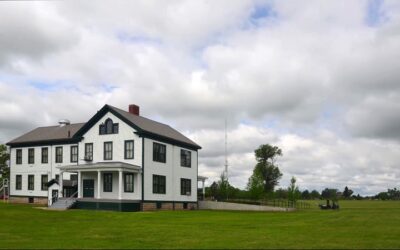
Detail of a circa-1875 stereograph of Courthouse and Jail Rocks. History Nebraska RG5899-14-1
By David L. Bristow, Editor
How were Courthouse and Jail Rocks formed?
Imagine the North Platte Valley filled to the brim with land, as it once was. Do you see the layers in Courthouse and Jail Rocks? They are mostly clay and silt that eroded from mountains to the west.
At the foot of Courthouse Rock, you stand on sediments laid down 35 million years ago. The top layers at the valley rim are about 10 million years younger. The river carved a path down through these layers. In time it became a broad valley.
Courthouse Rock is a remnant. Like Chimney Rock and Scotts Bluff, harder rock on top protected it as surrounding land eroded away.

“Court House R. from the S.,” 1851 drawing by William Quesenbury.
When did people arrive?
People have lived in the North Platte Valley for at least 13,000 years. Archaeologists have found ancient homes, campsites, and stone tools nearby.
Even before horses were brought from Europe, Indigenous trade networks spanned hundreds of miles. Local people exported surplus goods and imported items such as easily-flaked stone for toolmaking.
By the time Euroamerican emigrants began passing through this valley in the mid-1800s, this region was home to the Lakota, Cheyenne, and Arapaho peoples. Highly mobile on horseback, these northern plains tribes followed the bison herds. The people were forcibly removed to reservations in the 1860s and 1870s.

This 1859 stereograph of an Oglala Lakota village along the North Platte River is the earliest known photo of a Lakota village. History Nebraska RG3122-5-1
How did Courthouse Rock get its name?
This place has had many names in many languages, but most are lost to us. Travelers along the Oregon-California-Mormon trails called the main butte “the Court House” or sometimes “the Solitary Tower,” “the Church,” “the Capitol,” or “the Castle.” The smaller rock was “the Jail” or “Jail House.”

Captain Carlisle’s California Train. Emigrant wagon train nooning in the Platte Valley, 1859. History Nebraska RG3474-0-17
For westbound travelers the Court House marked a dramatic change of scenery after weeks crossing the Plains. They marveled at how it changed size and shape when seen from different angles and in different light.
Courthouse Rock also marks a crossroads of the main east-west trail with the Sidney-Black Hills Trail used during the 1870s Black Hills gold rush.

Map by Ben Kruse, History Nebraska
(Posted May 3, 2023.)




